July 10th, 2023
Discovering Central Park’s Above-ground Bedrock Foundations
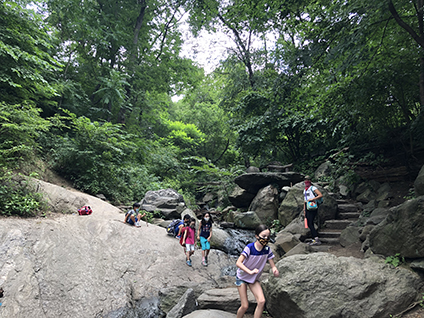 Reading histories of Central Park and viewing vintage stereopticon photographs and early postcards, I have time-traveler fantasies and wish that I could walk chronologically backwards and sequentially experience the park’s 160-year-old landscape and visitor scene. Dipping deeper in the waters of time, on my walks in the park I like to look at the bold rock outcrops and boulders known as “erratics” that you see in a pile at the south end of the Sheep Meadow and individually elsewhere throughout the Park. What I am now thinking about is the hand that nature took in the park’s original craftsmanship by creating the stony underpinnings of miles-deep metamorphosed mica schist and the surface exposures of this same 450 million-year-old formation that were revealed after the 2000-foot-high Wisconsin glacier passed over the northern parts of central and eastern North America 20,000 years ago. When I look around me I appreciate how successfully these rock outcrops were incorporated by the park’s designers Frederick Law Olmsted and Calvert Vaux into their Greensward Plan, the blueprint for the park’s construction. Besides punctuating its ground plane in a visually picturesque way, the surfaces of these great elephantine presences are invitations for sunbathers, picnickers, and climbing children.
Reading histories of Central Park and viewing vintage stereopticon photographs and early postcards, I have time-traveler fantasies and wish that I could walk chronologically backwards and sequentially experience the park’s 160-year-old landscape and visitor scene. Dipping deeper in the waters of time, on my walks in the park I like to look at the bold rock outcrops and boulders known as “erratics” that you see in a pile at the south end of the Sheep Meadow and individually elsewhere throughout the Park. What I am now thinking about is the hand that nature took in the park’s original craftsmanship by creating the stony underpinnings of miles-deep metamorphosed mica schist and the surface exposures of this same 450 million-year-old formation that were revealed after the 2000-foot-high Wisconsin glacier passed over the northern parts of central and eastern North America 20,000 years ago. When I look around me I appreciate how successfully these rock outcrops were incorporated by the park’s designers Frederick Law Olmsted and Calvert Vaux into their Greensward Plan, the blueprint for the park’s construction. Besides punctuating its ground plane in a visually picturesque way, the surfaces of these great elephantine presences are invitations for sunbathers, picnickers, and climbing children.
Like the glacially polished schist outcrops, the erratics are integral to the layout and building of Central Park and were often positioned in conjunction with the massive outcrops to increase their climbing potential.
While numerous outcrops were woven into the park’s design, their profusion meant that they could serve as quarries for the stonemasons who built the walls surrounding the entire perimeter of the park. Note that besides defining the 843-acre park’s rectilinear boundaries, the purpose of the perimeter wall is to serve as a means of protecting the park interior landscape from trespass and consequent damage.
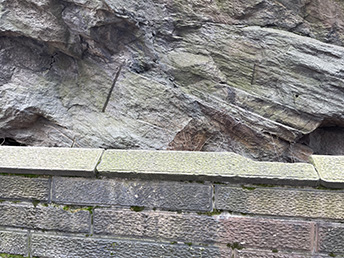
The same above-ground quarried schist that was cut and dressed as blocks of masonry for building the wall around Central Park was also used in the construction of several of the architectural features within it, most conspicuously the Belvedere castle. Evidence of the manner in which some rock outcroppings were fractured and then cut into pieces by stonemasons to serve as building blocks can be seen today in the form of occasional vertical grooves on their surfaces. Such marks represent the results of some bedrock outcrops having been blasted into various-size pieces by means of gunpowder poured into metal cylinders inserted into rock outcroppings in order to fracture them into transportable debris that could be converted into uniform blocks by stonecutters. Thus transformed into masonry, they could be used as on-site building material for the perimeter wall enclosing the park’s 843 acres and some necessary retaining walls, such as the ones embanking the park’s four sunken east-west transverse roads that segregate city traffic from the parks adjacent interior landscape. You will also find the same vertical grooves visible in individual blocks of stone masonry from which the low walls surrounding certain paved terraces within it were built.
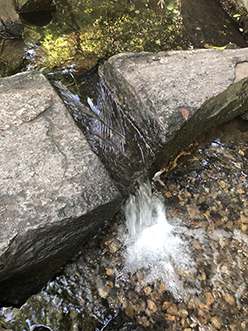 If you stroll beside the naturalistic stream named the Gill traversing the Ramble’s woodland landscape or walk in the park’s forested North End alongside the Loch, originally called Montagne’s Rivulet, from where it cascades over a mass of boulders below the West Drive and then takes a straight course through the Ravine, which was created by the two parallel hillsides opposite the park’s 102nd Street Cross Drive you will have a similar illusion of being in a completely non-urban setting. Walking east, you will want to pause at each of the three picturesque waterfalls that punctuate flow of the Loch in the same manner as the water in a runnel cut into a rock spanning the Gill enhances the sight of its flow through the Ramble. Today the well-positioned stone slabs over which the steam spills are maintained by the Central Park Conservancy, and it is possible to sit on one of them as you personally appreciate the preservation of the Loch’s original Olmstedian picturesque aesthetic.
If you stroll beside the naturalistic stream named the Gill traversing the Ramble’s woodland landscape or walk in the park’s forested North End alongside the Loch, originally called Montagne’s Rivulet, from where it cascades over a mass of boulders below the West Drive and then takes a straight course through the Ravine, which was created by the two parallel hillsides opposite the park’s 102nd Street Cross Drive you will have a similar illusion of being in a completely non-urban setting. Walking east, you will want to pause at each of the three picturesque waterfalls that punctuate flow of the Loch in the same manner as the water in a runnel cut into a rock spanning the Gill enhances the sight of its flow through the Ramble. Today the well-positioned stone slabs over which the steam spills are maintained by the Central Park Conservancy, and it is possible to sit on one of them as you personally appreciate the preservation of the Loch’s original Olmstedian picturesque aesthetic.
Before reaching its mouth at the Harlem Meer, the Lock will pass alongside Huddlestone Arch, the most impressive of the park’s several stone arches built for the purpose of grade-separation of traffic within the park’s ingenious multi-purpose circulation system. Note as you follow the pedestrian path beneath the arch that it is made entirely of huge uncut boulders and constructed without the use of mortar or other binding material.
The sight of Huddlestone will make you ponder how this entirely manmade park was constructed by the sheer brawn of its immigrant workforce without any modern mechanical equipment such as motorized winches, flatbed trucks, and electric drills. As I reflect on this, my mind is prone to consider the park’s great protruding substrata of Manhattan schist as the material both the foundations and building material from which these workers built Central Park.
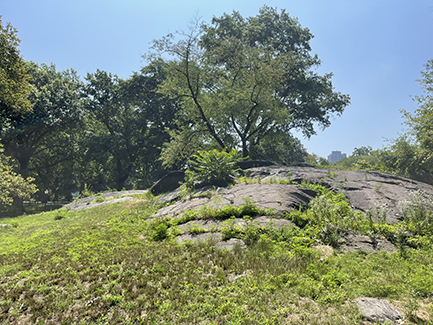 But observing the use of the park’s rock outcrops purely as an inherent geological endowment for architectural construction does not complete our understanding that the park in its entirety is a totally built environment designed to achieve a picturesquely naturalistic effect. All you have to do is to look at the grassy or wooded slopes that are grow out of natural crevices and fractures of Manhattan schist bedrock to notice the hill-and-dale effect you get where the topography has been modeled to rise and fall over inconspicuous rock outcrops. Observe also certain grassy patches with protruding rocks the size of wide benches on which people are sitting. When you are climbing up Cedar Hill near the park entrance at Fifth Avenue and 79th Street. Look at ground level on your way toward the East Drive and take note a patch of variegated Manhattan schist. In the winter, see how Cedar Hill has become the park’s favorite slope for sledding. As you continue your walk, keep on looking at grassy knolls with skirts of lawn at their bases and observe how these are good places for sitting or lying in the sun as well as throwing a ball to your dog or ten-year-old boy. Finally, don’t forget to note the tenacity of the tree roots that grow from soil beneath broken pieces of bedrock outcrops throughout the park.
But observing the use of the park’s rock outcrops purely as an inherent geological endowment for architectural construction does not complete our understanding that the park in its entirety is a totally built environment designed to achieve a picturesquely naturalistic effect. All you have to do is to look at the grassy or wooded slopes that are grow out of natural crevices and fractures of Manhattan schist bedrock to notice the hill-and-dale effect you get where the topography has been modeled to rise and fall over inconspicuous rock outcrops. Observe also certain grassy patches with protruding rocks the size of wide benches on which people are sitting. When you are climbing up Cedar Hill near the park entrance at Fifth Avenue and 79th Street. Look at ground level on your way toward the East Drive and take note a patch of variegated Manhattan schist. In the winter, see how Cedar Hill has become the park’s favorite slope for sledding. As you continue your walk, keep on looking at grassy knolls with skirts of lawn at their bases and observe how these are good places for sitting or lying in the sun as well as throwing a ball to your dog or ten-year-old boy. Finally, don’t forget to note the tenacity of the tree roots that grow from soil beneath broken pieces of bedrock outcrops throughout the park.
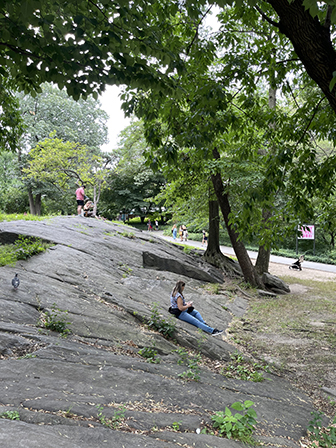 To see the park as a work of land art consisting of a sculptural mélange of rolling slopes with vegetation growing in relationship to the protruding rocks throughout simply take a walk in almost any area and let your eyes roll across the grounds with their exposed patches of bedrock, scattered erratic boulders, and pieces of quarried native Manhattan schist surrounded by a grassy ground-plane, which is often graced by a few nearby trees, shrubs, or wildflowers.
To see the park as a work of land art consisting of a sculptural mélange of rolling slopes with vegetation growing in relationship to the protruding rocks throughout simply take a walk in almost any area and let your eyes roll across the grounds with their exposed patches of bedrock, scattered erratic boulders, and pieces of quarried native Manhattan schist surrounded by a grassy ground-plane, which is often graced by a few nearby trees, shrubs, or wildflowers.
Of course, the laws of wild nature and the signs of its ubiquitous presence in Central Park is only half of the story. The park was not, as sometimes supposed, to be simply 843 undeveloped acres exempted from Manhattan’s grid plan for streets. It is that but much more, a scenic and recreational wonder that was entirely built by human hands. Here is what I wrote after the research for my book Frederick Law Olmsted’s New York, published in 1972:
Over the years, hundreds of thousands of cartloads of hundreds of thousands of cubic yards of rocks and glacial till – a sediment consisting of particles of various sizes and deposited by melting glaciers or ice sheets – were carried away or repositioned in the park, and hundreds of thousands of topsoil were brought in and spread over its surface. All the blasting and laborious hauling and earth-moving in the pre bulldozer days was, as Olmsted observed, only the priming of the canvass upon which the landscape artist would paint picturesque scenes, the full outlines of which would not be realized for a generation.
Thus, I am then compelled to think of Central Park as a multi-layered story written on a ream of paper, the sheets of which when read sequentially constitute a palimpsest in which each generation of builders, stewards, and users has etched a message. In some areas of the park the original surface on which the first lines of a localized piece of the Central Park palimpsest appear is that of an outcrop the park’s Manhattan schist bedrock. Two of the park’s most notable outcrops were used for building foundations – for instance, the Belvedere, which picturesquely appears to grow straight out of Vista Rock, and the archaeological remains of the primarily African-American community of Seneca Village, a cluster of fifty homes plus three churches and a school, which was sited atop Summit Rock (so named because it represents the highest point in Central Park) and its surrounding slopes within the area between West 82nd and West 85th Streets.
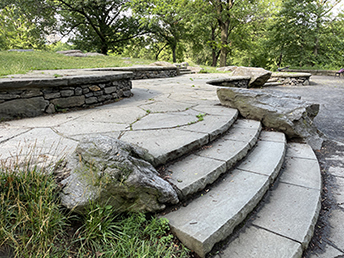 Since I happen to live on 81st Street and Central Park West and climb, or rather walk up the staircase carved into south side Summit Rock, on a regular basis. I hope you will read the journal entry I will post following this one, which will provide a deep dive into the notion of a landscape as a nature-based fundament for a multi-page palimpsest inscribed with the stories of several generations from the residents of Seneca Village, later the restoration project designers of the Central Park Conservancy, and now to the presenters of Central Park’s first Juneteenth holiday celebration two weeks ago.
Since I happen to live on 81st Street and Central Park West and climb, or rather walk up the staircase carved into south side Summit Rock, on a regular basis. I hope you will read the journal entry I will post following this one, which will provide a deep dive into the notion of a landscape as a nature-based fundament for a multi-page palimpsest inscribed with the stories of several generations from the residents of Seneca Village, later the restoration project designers of the Central Park Conservancy, and now to the presenters of Central Park’s first Juneteenth holiday celebration two weeks ago.
Share
